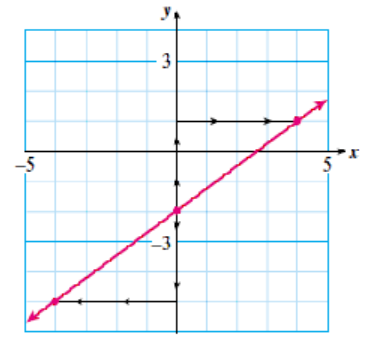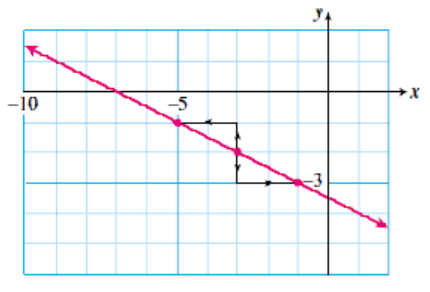Section 1.5 Equations of Lines
Subsection 1. Calculate slope using a formula
Recall that the subscripts on the coordinates in \(~P_1(x_1,y_1)~\) and \(~P_2(x_2,y_2)~\) just mean "first point" and "second point".
Two-Point Formula for Slope.
The slope of the line joining points \(~P_1(x_1,y_1)~\) and \(~P_2(x_2,y_2)~\) is
Subsubsection Example
Example 1.70.
Compute the slope of the line joining \((-6,2)\) and \((3,-1)\text{.}\)
It doesn't matter which point is \(P_1\) and which is \(P_2\text{,}\) so we choose \(P_1\) to be \((-6,2)\text{.}\) Then \((x_1,y_1)=(-6,2)\) and \((x_2,y_2)=(3,-1)\text{.}\) Thus,
Caution 1.71.
Make sure that you subtract both the \(x\) and \(y\) coordinates in the same order! That is, do NOT calculate
or your slope will have the wrong sign.
Subsubsection Exercises
Checkpoint 1.72.
Compute the slope of the line joining the points \((5,2)\) and \((8,7)\text{.}\)
Checkpoint 1.73.
Compute the slope of the line joining the points \((-3,-4)\) and \((-7,1)\text{.}\)
Subsection 2. Slope-Intercept Form
Because the \(y\)-intercept \((0,b)\) is the "starting value" of a linear model, and its rate of change is measured by its slope,\(m\text{,}\) the equation for a linear model
can be expressed in symbols as
Slope-Intercept Form.
If we write the equation of a linear function in the form,
then \(m\) is the slope of the line, and \(b\) is the \(y\)-intercept.
Subsubsection Examples
Example 1.74.
The temperature inside a pottery drying oven starts at 70 degrees and is rising at a rate of 0.5 degrees per minute. Write a function for the temperature, \(H\text{,}\) inside the oven after \(t\) minutes.
At \(t=0\text{,}\) the temperature is 70 degrees, so \(b=70\text{.}\)
The slope is given by the rate of increase of \(H\text{,}\) so \(m=0.5\text{.}\)
Thus, the function is
Example 1.75.
A perfect score on a driving test is 120 points, and you lose 4 points for each wrong answer. Write a function for your score, \(S\text{,}\) if you give \(n\) wrong answers.
If \(n=0\text{,}\) your score is 120, so \(b=120\text{.}\)
Your score decreases by 4 points per wrong answer, so \(m=\dfrac{\Delta S}{\Delta n} = 4\text{.}\)
The function is
Subsubsection Exercises
Checkpoint 1.76.
Monica has saved $7800 to live on while she attends college. She spends $600 a month. Write a function for the amount, \(S\text{,}\) in Monica's savings account after \(t\) months.
Checkpoint 1.77.
Jesse opened a new doughnut shop in an old store-front. He invested $2400 in remodeling and set-up, and he makes about $400 per week from the business. Write a function giving the shop's financial standing, \(F\text{,}\) after \(w\) weeks.
Subsection 3. Point-Slope Form
If we don't know the \(y\)-intercept of a line but we do know one other point and the slope, we can still find an equation for the line.
Point-Slope Formula.
To find an equation for the line of slope \(m\) passing through the point \((x_1,y_1)\text{,}\) use the point-slope formula
or
Subsubsection Example
Example 1.78.
Find an equation for the line that passes through \((1,3)\) and has slope \(-2\text{.}\)
We substitute \(x_1=\alert{1}\text{,}\) \(y_1=\alert{3}\text{,}\) and \(m=\alert{-2}\) into the point-slope formula.
Example 1.79.
Find an equation for the line of slope \(\dfrac{-1}{2}\) that passes through \((-3,-2)\text{.}\)
We substitute \(x_1=\alert{-3}\text{,}\) \(y_1=\alert{-2}\text{,}\) and \(m=\alert{\dfrac{-1}{2}}\) into the point-slope formula.
Subsubsection Exercises
Checkpoint 1.80.
Find an equation for the line of slope \(-4\) that passes through \((2,-5)\text{.}\)
Checkpoint 1.81.
Find an equation for the line of slope \(\dfrac{2}{3}\) that passes through \((-6,1)\text{.}\)
Subsection 4. Graphing a linear equation by the point-slope method
If we know one point on a line and its slope, we can sketch its graph without having to make a table of values.
Subsubsection Examples
Example 1.82.
Graph the line \(~y=\dfrac{3}{4}x-2\)
Step1: Begin by plotting the \(y\)-intercept, \((0,-2)\text{.}\)
Step 2: We use the slope, \(\dfrac{\Delta y}{\Delta x} = \dfrac{3}{4}\text{,}\) to find another point on the line, as follows. Start at the point \((0,-2)\) and move 3 units up and 4 units to the right. Plot a second point here, at \((4,1)\text{.}\)
Step 3: Find a third point by writing the slope as \(\dfrac{\Delta y}{\Delta x} = \dfrac{-3}{-4}\text{:}\) from \((0,-2)\text{,}\) move down 3 units and 4 units to the left. Plot a third point here, at \((-4,-5)\text{.}\)

Finally, draw a line through the three points.
Example 1.83.
Graph the line of slope \(\dfrac{-1}{2}\) that passes through \((-3,-2)\text{.}\)
Step 1: Begin by plotting the point \((-3,-2)\text{.}\)
Step 2: Use the slope, \(\dfrac{\Delta y}{\Delta x} = \dfrac{-1}{2}\text{,}\) to find another point on the line, as follows. Start at the point \((-3,-2)\) and move 1 unit down and 2 units to the right. Plot a second point here, at \((-1,-3)\text{.}\)
Step 3: Find a third point by writing the slope as \(\dfrac{\Delta y}{\Delta x} = \dfrac{1}{-2}\text{:}\) from \((-3,-2)\text{,}\) move 1 unit up and 2 units to the left. Plot a third point here, at \((-5,-1)\text{.}\)

Finally, draw a line through the three points.
Subsubsection Exercises
Checkpoint 1.84.
Graph the line \(~y=\dfrac{-1}{3}x-3\)
Checkpoint 1.85.
Graph the line with slope \(m=\dfrac{3}{2}\) passing through \((-1,-2)\text{.}\)
